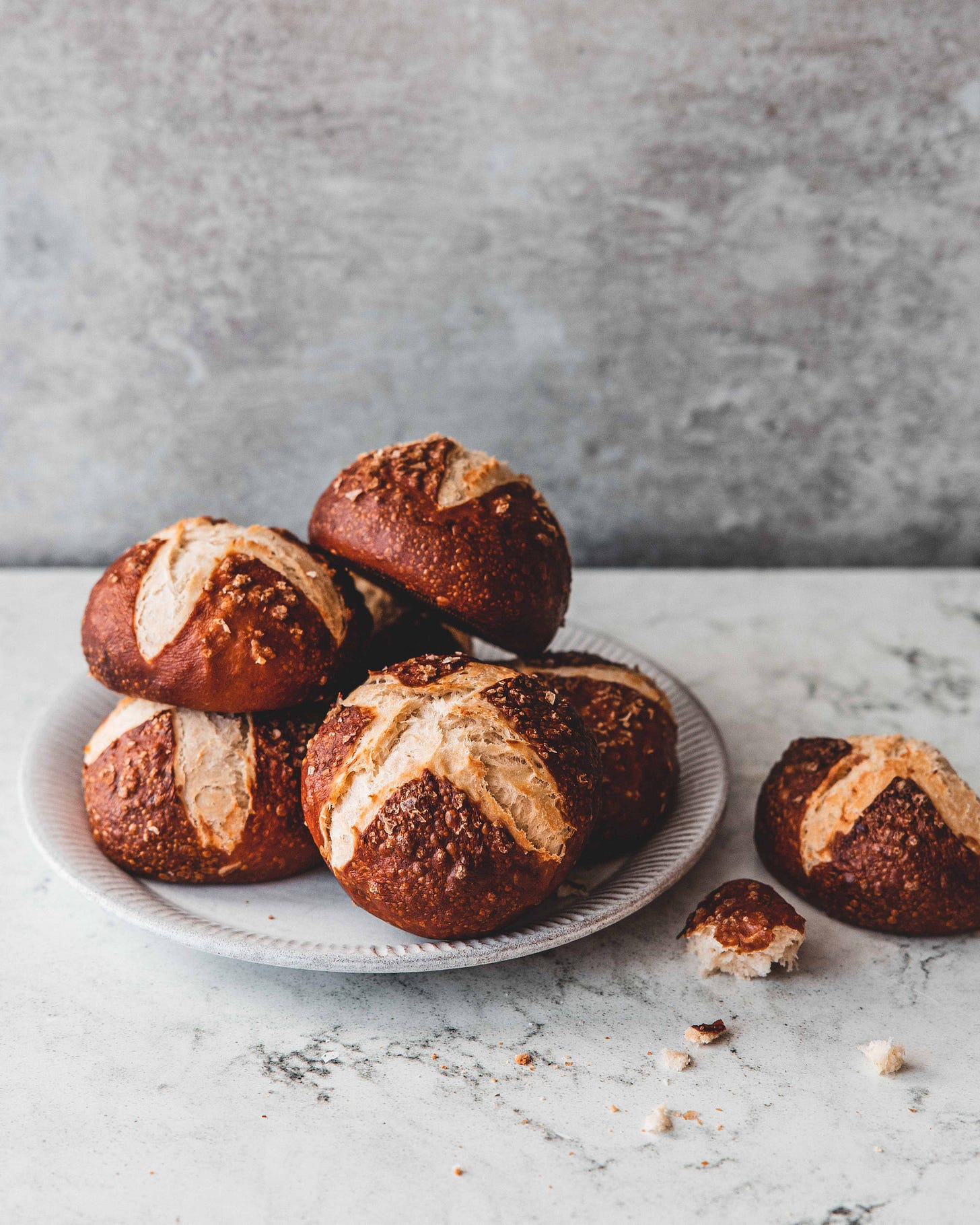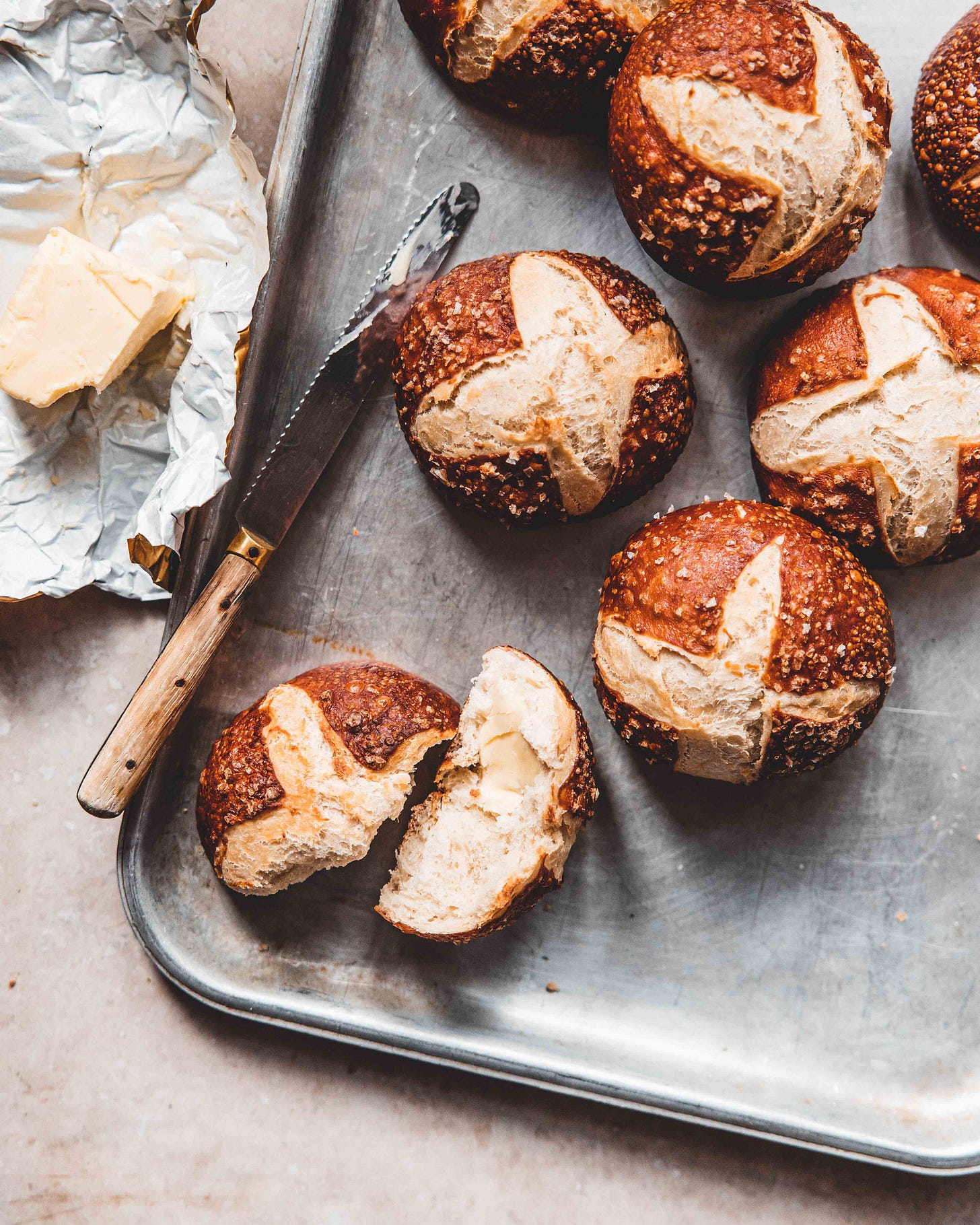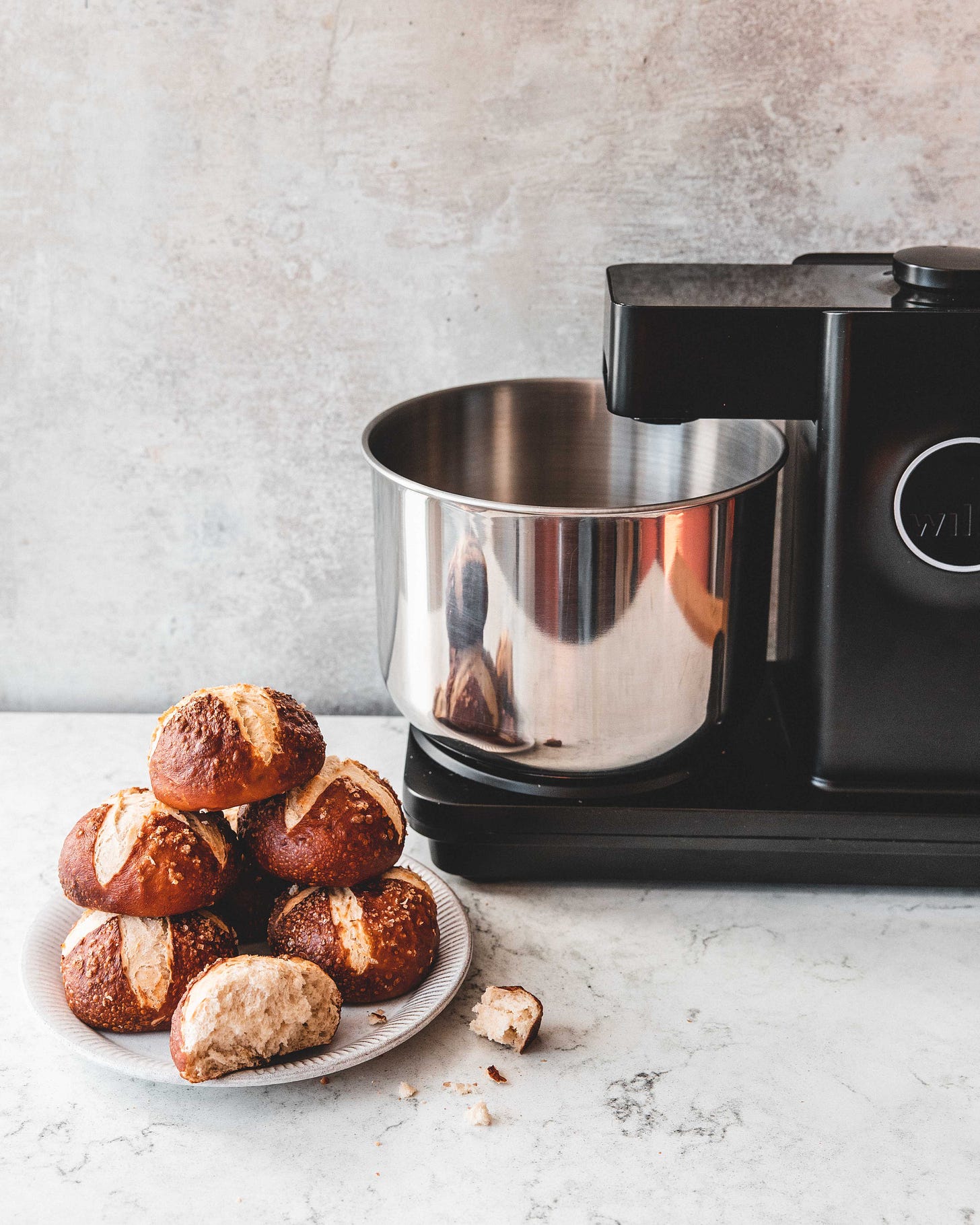This issue of the newsletter is sponsored by Wilfa
I often refer to my recipes as weekend projects, fun things to make over the weekend when time is more abundant. Today's recipe is both one of those projects and a bit of a science experiment; we're taking a trip back to your high school chemistry class to talk all things alkali. The recipe we are working on today is soft pretzel rolls, a roll with the flavour of a classic German pretzel but in the form of a soft pillowy roll, laugenbroetchen in German (literally translated as lye rolls or pretzel rolls).
Lye-dipped pretzels, or in this case, pretzel buns, have a distinctive flavour that is both savoury and slightly bitter. The lye, a strong alkaline solution, is used to give the pretzels their characteristic dark brown colour and chewy exterior. However, the lye also contributes to the unique flavour of the pretzels, giving them a slight tanginess and a hint of bitterness.
When you eat a traditional pretzel, you may notice a slightly metallic taste, which is a result of the chemical reaction between the lye and the dough. However, the overall flavour of the pretzel is more complex than just the taste of lye. The honey in my recipe adds a hint of sweetness that balances the flavour of the crust and the flavour from the lye.
So why is this recipe an experiment, you ask? Well, lye is not an ingredient you commonly find in home kitchens; it's a strong alkali and is an irritant and strong corrosive; you should use a level of caution if you choose to go down the traditional route and use lye; you need to wear protective clothing, work in a well-ventilated room and wear eye protection; You also want to make sure you are using food grade lye. And, take it from me, you want to avoid getting this on your countertops at all costs, especially if they're a porous stone or wood; stains appear so quickly if they come into contact with lye. I can hear you wondering, why even bother? There must be a safer alternative? First, the flavour you get from lye is much stronger than the alternatives; plus, how often do you mix baking with something straight out of Breaking Bad (did you know some cartels are known to dissolve bodies with lye?). If I have put you off ever using lye, don't worry, I will show you two alternatives and if I haven't put you off, please do some more reading on using lye safely before you dive in; lye is not an ingredient to you should be messing around with.
Lye is actually used in food manufacturing quite a lot, in everything from the curing of fish to the canning of mandarins. As it's a strong corrosive, lye is used in many cleaning products; I'm not doing a great job selling this to you, am I? When you mix lye and water, you trigger an exothermic reaction; this chemical reaction supercharges the Maillard reaction resulting in bread with a shiny, mahogany-coloured crust. The question you may be left with is; how on earth is anything made with lye safe to eat? In the case of baked goods, the bread gives off carbon dioxide as it bakes, which reacts with the lye and turns it into a benign carbonate. When you are finished making the rolls, the lye solution can be poured down the sink followed by a few seconds of tap water. Make sure to thoroughly wash everything that has come into contact with the lye, keeping your gloves on while you do so.
Alternatives
If you prefer using something other than lye, you have two alternatives: baking soda and...baking soda. There are two ways to use the same old bicarbonate of soda; the first is straight from the jar, and the second is baking the soda first. Lye is a powerful alkali; regular baking soda doesn't come close to its strength, even though it is also an alkali. If you make the pretzel rolls with regular baking soda, they'll turn a nice dark brown, but they'll be no gloss to the crust, and most importantly, the flavour the alkali adds will be much more subtle. It is, however, the most straightforward alternative to lye. The second way to use baking soda is to bake it first. Baking it at 180ºC (350ºF) on a foil-lined baking tray changes the sodium bicarbonate to sodium carbonate, increasing its strength and bringing it closer to lye. This process means the pretzel rolls made with this supercharged baking soda will be a touch darker, have more shine to them and, most importantly, have more of that classic pretzel flavour when compared to versions made with baking soda.
Baked Baking Soda
To make this supercharged baking soda, line a small baking tray with kitchen foil, tip out a whole jar of baking soda, and spread it into an even layer. Bake at 180ºC (350ºF) for an hour (if using a large container of baking soda, you may need to extend this time). It won't look like anything has happened, but you can tell it is ready when you weigh the baking soda. The transformation is complete when the soda has lost about a third of its initial weight. The resulting powder is a stronger alkali than regular baking soda, and because of this, some additional care should be taken when using it. In addition, the transformation to sodium carbonate makes the powder a mild irritant, so it should be stored in a sealed container, and the best practice would be to use gloves when handling it.
If you would like to learn more about how baked baking soda works, food scientist Harold McGee wrote a brilliant piece for the New York Times a number of years ago
Finally, The Pretzels
Okay, now that we are done with today's science lesson, let’s talk about how we actually make the pretzel rolls themselves. The dough is relatively simple, made with bread flour, yeast, salt, water, a little butter and a little honey. The butter and the honey contribute to the softness of the bun and add a hint of sweetness that balances out the slight bitterness in the crust. I make the rolls with 70% hydration, meaning I prefer to knead the dough in my Wilfa Pro Baker as it can be a little sticky by hand. The dough is made simply by throwing everything into the bowl of the mixer and letting it do its thing. In the Pro Baker, the dough takes about 10 minutes to become smooth and elastic, and because it is such a stable and well-designed machine, I can get on with something else in that time, knowing I never have to worry about it dancing across the work surface. The capacity of the Pro Baker is also massive; it can handle 5kg of dough, so if you want to scale up this recipe to make a bigger batch of rolls, knock yourself out. If you don’t know by now, I love the Pro Baker, it really is the best mixer I have ever used to make bread.
Don't forget you can get 20% off Wilfa products on their site, using my code THEBOYWHOBAKES at checkout.
Soft Pretzel Rolls
Makes 9
500g strong white bread flour
7g fast-action dried yeast
10g fine sea salt
350ml lukewarm water
30g unsalted butter, melted
2 tbsp honey
To make the pretzel dough place the flour, yeast and salt into the bowl of the Wilfa Pro Baker fitted with the dough hook and mix briefly to distribute. Next, whisk together the water, butter and honey in a large jug. Pour the liquid ingredients into the bowl of the mixer and mix on medium speed until a shaggy dough has formed. Continue kneading the dough for roughly 10 minutes or until the dough is smooth and elastic.
Scrape the dough onto the work surface and form it into a ball. Place the dough into a lightly greased bowl and cover, setting aside for an hour or until the dough has doubled in size.
Turn out the dough and press it into a flat round, degassing the dough as you do so. Cut the dough into nine equal-sized pieces, weighing about 100g a piece. Form each piece of dough into neat rounds of dough and place onto parchment-lined baking trays. Cover with a damp kitchen towel and set aside for about 40 minutes or until risen and puffy but not yet doubled in size.
If using lye, taking all the safety precautions needed, make a 3% lye solution. Using non-reactive materials such as a glass or stainless steel bowl and a stainless steel whisk, dissolve 30g of lye in 1 litre of water. If using regular or baked baking soda, bring 1 litre of water to a very low simmer and add 3 tbsp baking soda.
Preheat the oven to 200ºC (180ºC Fan).
If using the lye solution, using protective gloves, dip the rolls into the solution for 30 seconds, 15 seconds per side. Transfer the rolls back to the baking tray using a stainless steel slotted spoon or your protected hands. If using either type of baking soda, simmer the rolls for 1 minute, 30 seconds per side. Use a slotted spoon to transfer them back to the baking trays.
Sprinkle the rolls with flaked sea salt. Cut a cross onto each bun using a very sharp knife or a razor blade. Bake in the preheated oven for about 15 minutes or until the buns are a deep mahogany brown colour. Remove the rolls from the oven and allow them to cool before eating.







Edd - Did you find the flavor of the soda-based treatments to be acceptable? Because in my experience, they benefit from a rinse/dunk in clean water to eliminate that soapy flavor.